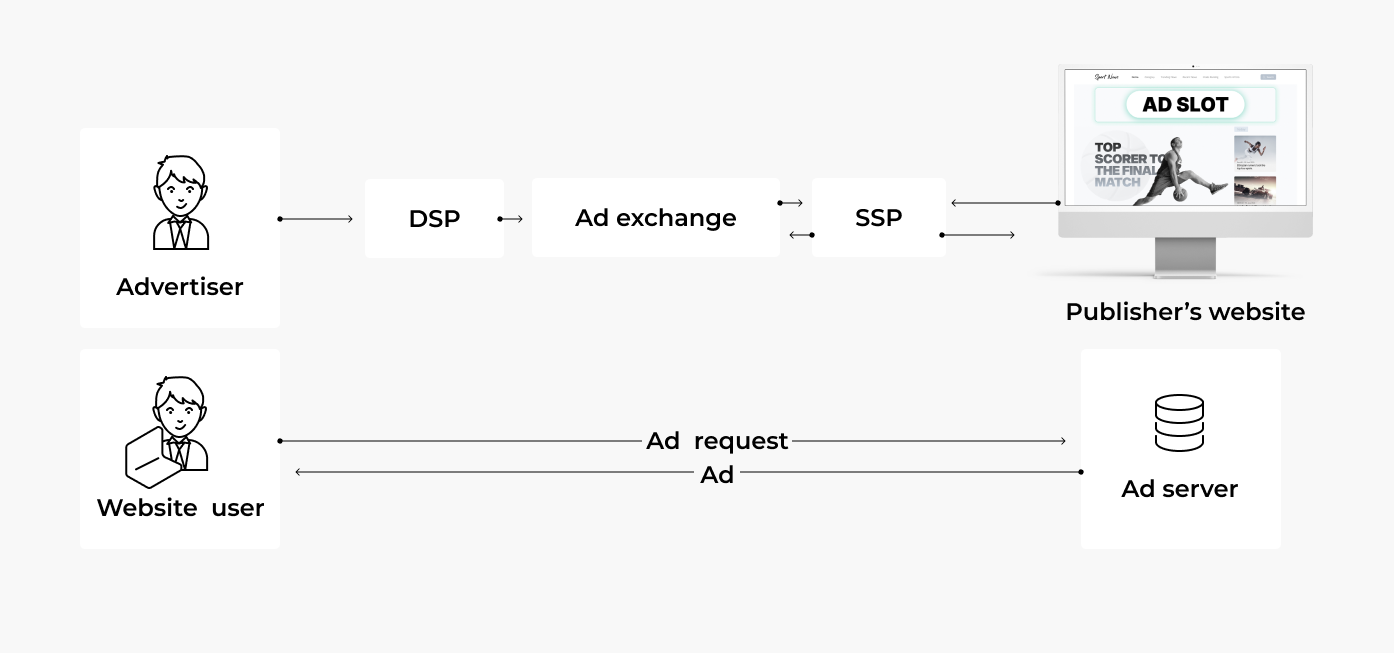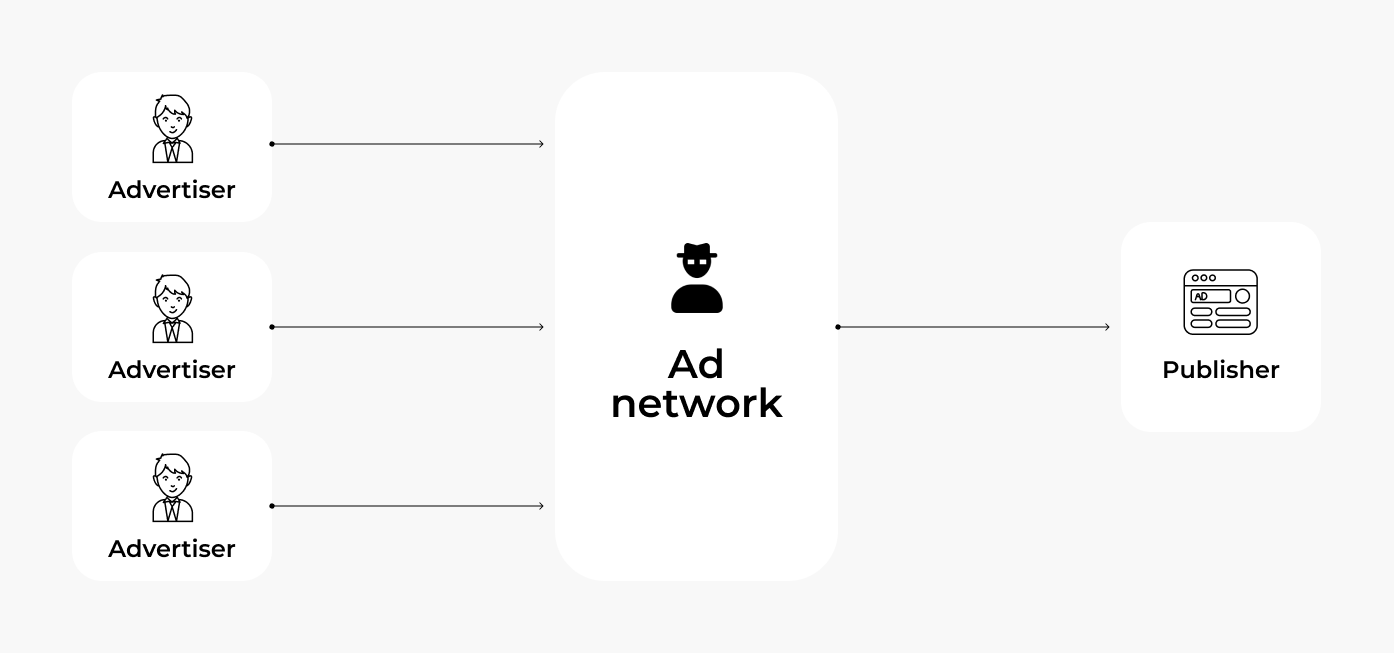What does the perfect yield boost for your website depend on?
Approaching the wilds of yield optimization can feel a lot like a bustling bazaar in Marrakech. But instead of being lured by exotic goods at every corner, you’re swarmed by a kaleidoscope of ad networks, exchanges, servers, SSPs, and platforms, each willing to increase your website’s ad revenue. Or promising to do so.
While the sheer number of options can be puzzling, the solutions themselves are usually pretty straightforward. They, to oversimplify, boil down to the exact obstacles you might be facing and the journey you’ve already passed collaborating with different AdTech vendors, their business model, analytical capabilities, etc.
In this article, we’ll go over such common thorny issues publishers face and look at the techniques that make yield optimization a lot less cumbersome to pull off.

SSP or ad server: Weighting the options for better ad inventory monetization
To clear up any initial confusion, let’s first define the canonical functions of an ad server and a supply-side platform (SSP). Indeed, certain SSPs now provide services that traditionally fell under the domain of an ad server. Some even offer fully integrated ad servers within their SSP platforms. However, it’s important to note that these are distinct services.
An ad server serves as the backbone for storing, preparing, dynamically selecting, and delivering relevant ads based on predefined campaign parameters on a publisher’s website. Unlike SSPs, it focuses on managing ad creative files and doesn’t facilitate advertiser connections to the programmatic ecosystem.
Publishers have the option to either host their ad server or utilize third-party services for hosting and management. A prime example of a hosted ad server is Google Ad Manager that seamlessly integrates with their ad exchange to streamline demand reception.
From the publisher’s perspective, an SSP offers a means to diversify advertising demand beyond reliance on a single platform. It enables access to various demand sources across different platforms and exchanges connected to the SSP. However, it may lack certain functionalities of an ad server.
The clarity hasn’t likely improved much yet, right? Okay, let’s pivot back to the heart of the matter: Which choice is truly the optimal one for a publisher and their cherished website?
Expert key headnotes
1. Opting for a hosted ad server means relinquishing full control of your data. Additionally, your customization options are restricted by the limitations imposed by the host.
2. While a self-hosted ad server could be a potential solution, it still comes with its own set of drawbacks. And constant updates, integration challenges, and maintenance burdens are not the only ad server drawbacks. Because while having your own ad server offers direct control over creatives and reporting, it lacks one crucial ability — to set a price floor.
Let’s take a closer look at it and why it’s vital. In general, there are two pricing mechanisms:
| Second-Price Auction (SPA) | First-Price Auction (FPA) |
| Winner pays the price of the second-highest bid plus a minimal increment | Winner pays their bid amount |
As the first-price auction method gains traction, advertisers are embracing a strategy known as bid shading. Utilizing both algorithmic and non-algorithmic tools, AdTech partners determine a value that falls between the second-price and first-price bids, aiming to secure impressions at the most competitive rate. Naturally, this practice leads to a reduction in profits for publishers.
In response, there was created a solution — price floor optimization — that ensures publishers receive a fair deal for their inventory.
So, an SSP can adaptively modify your minimum price threshold according to a curve representing the relationship between fill-rate and price. It can progressively elevate this threshold until the point where further price increments begin to diminish overall yield due to a plateauing demand curve, causing fill rates to decline beyond compensatory levels. Likewise, it can give precedence to ad networks with the most substantial incoming bids and fill rates.
3. Another crucial aspect to consider stems from the direct purpose of these tools: For ad servers, it’s ad serving, while SSPs primarily focus on managing inventory and facilitating resale. Essentially, SSPs empower publishers to capitalize on surplus ad space in real-time, enabling them to optimize the value of each pageview.
4. And yes, with an ad server, you have the autonomy to serve ads according to your own guidelines, although without any profit assurances. Conversely, utilizing an SSP entails adhering to its delivery rules, relinquishing some control, but with the assurance of generating revenue by the end of the month.
Oxagile’s verdict
- In short, the ideal solution for publishers seeking to optimize yield is an SSP equipped with additional features.
- However, publishers can also opt for a combination of an SSP and an ad server, such as Google Ad Manager, to retain control over ad serving orders while benefiting from SSP revenue assurance. In this case, monetization of the available ad space for every single page view would look like this:
- The page calls its Ad Server to display pre-purchased ads.
- Any remaining ad space triggers a bid request to the SSP.
- The SSP auctions off the bid through an ad exchange, where demand-side platforms and ad networks bid on it.
Struggle to confront previous failures. Finding your right ad network fit

If you’re still finding your footing in the world of advertising or have fairly low traffic and are on the hunt for the most effective way to sell ad space, it’s likely you’ve encountered platforms that either underperform or have limited functionality in reporting or other perks. In such a case, our expert suggests several potential scenarios that would be most optimal for you.
Oxagile’s AdTech expert recommends
Scenario A: Connecting to multiple partners
One effective method, which is both straightforward and highly beneficial, involves connecting with a wide array of multiple demand partners (SSPs/ad exchanges) in your region.
There are two avenues for accessing demand partners: Either directly contacting them for assistance with monetization, or engaging with third-party partners who can facilitate access to premier demand partners (such as PubMatic and OpenX).
Scenario B: Relying on an intermediary
Another possibility to explore involves collaborating with an AdTech middleman.
Such middlemen gather mid-scale publishers, enabling them to tap into larger ad exchanges and connect with extensive ad networks and SSPs. These intermediaries may also offer their solutions for optimizing yield, akin to SSPs but with additional features, providing more comprehensive market insights regarding pricing, competition, and even recommendations for ad layout optimization.
Plus, they can grant several websites access to their GAM account, which they configured themselves, with ad exchange, header bidding, and lots of other third-party partners.
Scenario C: Applying header bidding for selling a part of the traffic
Using both header bidding and waterfall approaches offers another way to work things out, optimizing yield. You can start off with header bidding for your top inventories and then proceed to sell the rest through the waterfall method. This ensures comprehensive inventory sales, while maintaining optimal pricing throughout the process.
The waterfall method, or ad network waterfall, is a sequential process where ad requests are sent to various ad networks or demand sources in a predetermined order until an ad is successfully filled.
Header bidding transforms the conventional approach of soliciting bids from buyers one by one. Instead of sending bid requests individually, all selected buyers receive simultaneous bid requests from the publisher. Unaware of each other’s bids, each buyer submits an offer for the same inventory. The bids are then relayed back to the publisher’s header bidding server or wrapper, where the highest bid wins the inventory.
The beauty of the waterfall approach is that it enables publishers to observe the origins of demand along with the monetary worth of their bids. Consequently, publishers can optimize for the highest cost per mille (CPM) attainable.
Transparency challenges. Alternatives to black box solutions

Sometimes, even using generally decent solutions for ad revenue optimization raises questions. These questions arise not only due to the high and impractical service costs associated with these solutions but also because of the lack of precise information about internal calculation mechanisms and analytics, since transparency in processes is precisely what provides confidence that you are getting the best price for your ad inventory.
A black box solution is the one that keeps its inner workings concealed or not entirely clear to the user. Essentially, users are aware of what inputs are needed and can see the results, but they don’t have a thorough grasp of how the system operates to produce those outcomes.
What does a good solution look like in this case?
A publisher has the option to develop an in-house bid floor optimization solution. By doing so, they can address several challenges:
- Improved reporting visibility: With an in-house solution, the publisher gains better visibility into bid floor performance. They can track and analyze data more effectively, leading to informed decisions.
- Enhanced comparison metrics: An in-house system allows for detailed cohort-like comparisons. Publishers can compare bid floor performance across different segments, identify trends, and optimize accordingly.
- Revenue share efficiency: Unlike external partners, an in-house solution eliminates the need to share revenue. The publisher retains the entire revenue generated through the bid floor.
Wrapping up
The challenges that publishers face in their pursuit of maximizing revenue through yield optimization are multifaceted and extend beyond the ones we’ve outlined. For instance, there are overarching concerns like the manual input of various parameters and setups across different advertising systems, which could greatly benefit from automation, potentially by leveraging AI technology.
Additionally, there’s a growing opportunity to incorporate AI for analyzing data insights and guiding decision-making processes, such as adjusting bidding prices, refining targeting strategies, and implementing whitelisting or blacklisting practices, to name a few.
The list of solutions addressing challenges that may impede websites from attaining optimal profitability is extensive, and our experts are eager to delve into them further. Given that optimization is a journey rather than a quick fix, we can offer our guidance based on deep AdTech expertise at any point along your inventory monetization path.


























